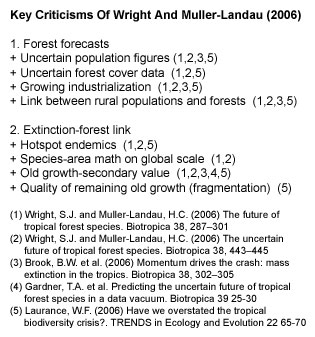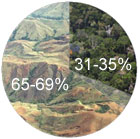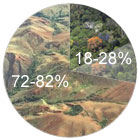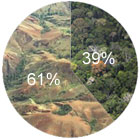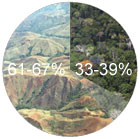A debate erupts in the halls of conservation science
In recent years, scientists have warned of a looming biodiversity extinction crisis, one that will rival or exceed the five historic mass extinctions that occurred millions of years ago. Unlike these past extinctions, which were variously the result of catastrophic climate change, extraterrestrial collisions, atmospheric poisoning, and hyperactive volcanism, the current extinction event is one of our own making, fueled mainly by habitat destruction and, to a lesser extent, over-exploitation of certain species. While few scientists doubt species extinction is occurring, the degree to which it will occur in the future has long been subject of debate in conservation literature. Looking solely at species loss resulting from tropical deforestation, some researchers have forecast extinction rates as high as 75 percent.
Now a new paper, published in Biotropica, argues that the most dire of these projections may be overstated. Using models that show lower rates of forest loss based on slowing population growth and other factors, Joseph Wright from the Smithsonian Tropical Research Institute in Panama and Helene Muller-Landau from the University of Minnesota say that species loss may be more moderate than the commonly cited figures. While some scientists have criticized their work as “overly optimistic,” prominent biologists say that their research has ignited an important discussion and raises fundamental questions about future conservation priorities and research efforts. This could ultimately result in more effective strategies for conserving biological diversity, they say.
 Monkey frog in Peru (photo by Rhett A. Butler). Scientists are particularly concerned about the global decline of amphibians over the past 20 years. Recent research suggests that the amphibian crisis is tied to global warming. |
“[Though] I believe [the Wright and Muller-Landau study] seriously understates the tropical biodiversity crisis,” said William F. Laurance, an ecologist also from the Smithsonian Tropical Research Institute, their work “provides a clear rationale for projecting future species losses and highlights pressing research priorities” and “has precipitated a vigorous scientific debate.” Laurance summarized and responded to Wright and Muller-Landau in a paper published in TRENDS in Ecology and Evolution.
Summary of Wright/Muller-Landau conclusions:
declining population growth will slow net deforestation
and cut projected species extinction by 2030
In their initial paper, titled “The future of tropical forest species” and published in 2006 in Biotropica, Wright and Muller-Landau demonstrate a relationship between human population density—especially in rural areas—and forest cover, suggesting that most deforestation results from subsistence slash-and-burn agriculture. Having established this relationship, the authors point to slowing rural population growth rates in most of the world resulting from lower birth rates and urbanization—especially in Asia and Latin America.
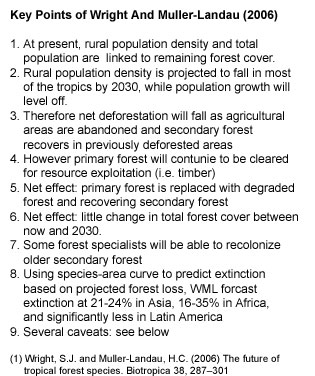
|
On the basis of these lower rural growth rates, Wright and Muller-Landau argue that deforestation rates will slow. Overall, their model projects that net forest cover will not change much between now and 2030, though primary forest will be replaced by secondary forest. Using the species-area curve, which holds that there exists a tight correlation between the area of habitat and the number of species, the authors forecast a 21 percent to 24 percent extinction in Africa, 16 percent to 35 percent in Africa, and more moderate extinction rates in Latin America, though they don’t offer an estimate. They argue that many species currently at risk from habitat loss will not go extinct in the end and instead will benefit from the projected abandonment of agricultural lands and subsequent regrowth of secondary forest in the absence of rural farmers practicing swidden agriculture.
The authors concede that while secondary forest is not as biodiverse as old growth or primary forest, in a historical context tropical forests have retreated to small areas before, namely during the Ice Ages under the refugia hypothesis. Further, they say, forest species that exist today have managed thus far to survive extensive hunting and land-clearing pressure from large sustained indigenous populations in the Amazon, Congo, and New Guinea.
While the argument seems straightforward, it is extremely controversial in the realm of conservation biology. Wright and Muller-Landau present their findings with several caveats which have helped spark a traditional scientific debate in which researchers respond deliberately, but sometimes heatedly, to one another through scientific journals.
Wright/Muller-Landau: the Forests of 2030
Like other researchers, the two authors expect ongoing destruction of primary forests for agriculture and resource extraction, namely timber harvesting. They in fact predict that “in the future, most tropical forests will be secondary forests regenerating after previous clearing” and that “relatively undisturbed old growth or primary forests will become increasingly rare.” They say that in the future, even more so than today, most primary forest will be restricted to protected areas and “areas that have low human population densities and are not valuable for agriculture or other development and to effective protected areas,” namely the Amazon basin, the Guiana shield (Guyana, French Guiana, Suriname), Papua New Guinea, and Gabon.
Overall, Wright and Muller-Landau forecast little net change in forest cover between now and 2030.
-
“Specifically, we expect that in the next 25 years the rate of net tropical deforestation will slow on all continents. Further, we predict a switch to a net increase in forest area in Latin America and Asia if not within 25 than at least within 50 years, and in Africa within 100 years. The fundamental causes of such changes will be stabilizing human populations and thus stabilizing demand for agricultural commodities, increased nonagricultural economic opportunities in developing countries, and increased agricultural land use efficiency due to continuing technological improvements and their more widespread use. Our optimism is consistent with past changes in population size, agricultural yields, and cropland area in developing countries. . . . Finally, there is reason to believe that in tropical countries in the future, as in developed temperate countries in the past, increasing per capita income will eventually bring increasing demand for environmental goods, including native forest protection.”
The authors note that this trend, where forest loss slows and eventually reverses, has been observed in the developed world—especially in Europe and the United States—and is starting to occur in some wealthier developing states, including Costa Rica, Dominican Republic, and Puerto Rico.
The authors’ predictions are based largely on a log-linear relationship between human population density and the percentage of original forest cover remaining. “This means that a geometric or multiplicative increase in population density is associated with an arithmetic decline in forest cover,” Wright explained to mongabay.com via e-mail. “The slopes of these log-linear relationships are quite steep. My favorite example is the Democratic Republic of the Congo. The UN projects a 300 percent increase in human population by 2050. But, the log-linear relation between forest cover and human population density suggests that this might be associated with a much more modest decline in forest cover from about 60 percent today to about 35 percent in 2050. The key to our projections is the log-linear form of the relationship.”
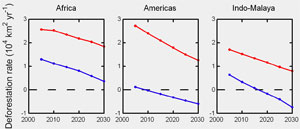 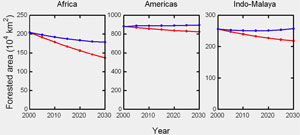
Future net deforestation rates (upper panels) and forested area (lower panels) predicted from total (open symbols, dotted lines) and rural (solid symbols and lines) population growth. The dashed horizontal lines represent zero net deforestation in the upper panels. Negative net deforestation rates represent net increases in forest area. The predictions incorporate continent-specific, cross-country relationships between forest area and population density in 2000 and population growth anticipated by the UN Population Division. All figures are for the 45 humid tropical countries that support 89.6 percent of all extant tropical |

Complete deforestation, like this seen in Madagascar, is a particular concern since there is little chance of secondary forest recovery on heavily degraded soils. Madagascar is ranked as one of the highest conservation priorities in the world for its large numbers of endemic species and widespread forest loss. |
Some researchers object to this link between human population density and deforestation, and even Wright and Muller-Landau offer qualifications to their forecasts, notably that the relationship between deforestation and population density could change. They cite an example of how the ratio between rural population density and deforestation could shift in the opposite direction. In parts of Rondonia state (Brazil), they note, the transition to mechanized large-scale farms has produced a decline in population density, but has not reduced deforestation. Looking at the whole picture, critics say, the relationship going forward is entirely unpredictable on a global scale.
A Biotropica paper by Barry W. Brook, from Charles Darwin University in Australia, and colleagues, says that Wright and Muller-Landau may have oversimplified the relationship between deforestation and rural population growth, noting that “even those people not residing in rural areas (and thereby not impacting forests directly) will nevertheless drive an increasing demand for basic necessities (food, timber for housing, and fuel) and the raw materials for economic development.”
Laurance agrees with Brook and his colleagues. “Wright and Muller-Landau also assume that population density and forest cover will remain strongly correlated, but this relationship is changing as both industrialization and per-capita consumption increase rapidly in developing nations,” he writes. “Industrial drivers of tropical deforestation, such as large-scale cattle ranching, soy farming, oil-palm plantations, timber extraction, oil and gas development, and major highways and infrastructure projects, have risen markedly in importance during the past two decades. This trend will surely continue, with global industrial activity expected to expand three- to six-fold by 2050, and with potentially dramatic increases in land demands for biofuel production. Hence, in many tropical regions, future pressures on forests will be determined more strongly by industrial drivers, globalization and macroeconomic forces than by local population density.”
In response, Wright says that some critics appear to be putting too much emphasis on the rural population projections and not enough on the relationship between forest cover and total population growth.
“I am unsure why our readers come away believing that our projections rest solely on rural population projections,” Wright told mongabay.com. “We were stunned at the strength of the relationships between forest cover and rural population density, but the relationships with total population density are also quite strong. . . . We made our projections based on rural population only and on total population including rural and urban populations throughout the original paper. Due to the log-linear form of the relationship . . . our projections are actually quite robust to the inclusion or exclusion of the urban population.”
Still, Wright and Muller-Landau acknowledge that an increasingly global economy could cause changes in forest cover to be decoupled from population trends, responding instead to global markets. They write:
“Global food needs are unlikely to result in a large expansion of the worldwide area in agriculture, given increasing agricultural yields, especially in the tropics (Green et al. 2005), although increasing meat consumption in developing countries could substantially increase the per capita impact on forest cover (Green et al. 2005). However, increased trade liberalization could lead to shifts in agricultural production from temperate to tropical countries, increasing pressure on tropical forests. Energy demand represents a potentially larger danger to tropical forests if biofuels are developed on large scales: the production of sugarcane for ethanol, oil palm for palm oil, and plantation trees for wood could easily replace all natural forests (Pacala & Socolow 2004). Thus, agricultural trade liberalization and large-scale increases in biofuel production could both lead to increased demand for tropical land, and change land-use dynamics in such a way that country-level population densities, rural or urban, cease to predict forest cover. . . . We expect that there will be significant changes in the labor-intensity of land use and in rural employment options in tropical countries as development and globalization proceed. How these changes will interact to affect the relationship between rural population density and forest area remains to be seen”
Questions on data quality
In addition to the controversy over the relationship between rural population density and forest area, the population and forest data themselves are questionable, a concern raised by Wright and Muller-Landau, who say their projections are based on the best available figures. While they estimate that 35 percent to 50 percent of world’s original tropical cover is gone, they note that the data for individual countries is poor and they must rely on somewhat “dicey” figures provided by the U.N. Food and Agriculture Organization (FAO).
Beyond forest cover and deforestation statistics, some experts doubt that existing population data is reliable enough to forecast long-term trends.
“The UN population projections such as those used by Wright and Muller-Landau also contain large uncertainties,” writes Laurance in his TRENDS in Ecology and Evolution paper. “Such projections are sensitive to a range of assumptions about future human behavior, some of which are merely informed speculation. . . . There is also much uncertainty in urban and rural population trends in developing countries, especially when examined at a subnational level. In the words of a leading population researcher, no professional demographer takes the UN median projection as seriously as nondemographers such as Wright are doing.’ (R. Engelman, pers. commun.)”
Biodiversity extinction forecasts based on deforestation projections…
The debate gets especially contentious when it comes to the biodiversity implications. What do the Wright/Muller-Landau forecasts, even if they come to pass, mean for global biodiversity? Well no one really knows—there is a paucity of data. This lack of reliable data only fuels the increasingly heated debate.
First, a look at their projections.
Wright and Muller-Landau projections
|
|
Africa
|
Forest cover in Africa (2000): 31-35% Projected cover in Africa (2030): 18-28% Projected extinction in Africa (2030): 16-35%
|
Indo-Malaya
|
Forest cover in Indo-Malaya (2000): 39% Projected cover in Indo-Malaya (2030): 33-39% Projected extinction in Indo-Malaya (2030): 21-24% | |||
The two authors use a standard species-area curve to project future species extinction. The species-area curve is a power function that is used to calculate the number of species in a given area, which can then be applied to estimate how many species go extinct when habitat is lost. Since the relationship is logarithmic, a 10 percent reduction in habitat does not result in a 10 percent extinction of species. Depending on the types of organisms involved, the model forecasts roughly a 10 percent to 20 percent extinction of species for a 50 percent reduction in habitat, whereas a 90 percent reduction in habitat would produce a 50 percent extinction rate. The authors note that the current global loss of tropical forests already approaches the 20 percent threshold.
Based on this function and their projected loss of forest by 2030, Wright and Muller-Landau forecast biodiversity loss of 21 percent to 24 percent for species in the Asian tropics and 16-35 percent for species in the African tropics. They do not venture an estimate for Neotropical species due to differing treatment of tropical savanna habitat in Brazil. Nevertheless they are considerably more optimistic about biodiversity in the American tropics.
“At a regional scale, the situation is most favorable in Latin America,” they write. “Here, percent of forest remaining is relatively high . . . Low projected population growth and intense urbanization suggest that a substantial net increase in forest area may occur before 2030, and the population is expected to grow by just 10 percent between 2030 and its peak level in 2065.”
In Asia, they note, remaining forest cover is already quite low, and while population growth is only expected to be 13 percent by 2030, much of Asia’s biodiversity will be dependent on Indonesia, where forest degradation is expected to continue to be severe due to clearing for biofuel crops, logging, and forest fires. The outlook for Africa is particularly bleak, say the authors, with high levels of net deforestation expected through 2030 and continued expansion of human population—by 65 percent—between 2030 and its peak level in 2100. “The conservation crisis that threatens the Asian tropics today is likely to affect the African tropics in the near future,” they warn.
“The extinction projections come from a very simple species area calculation. We all use the same method,” Wright told mongabay.com. “The difference comes in the input. The conservation literature routinely claims that a much larger percentage of tropical forest will be lost.”
… with some caveats
Wright and Muller-Landau caution that their extinction estimates are uncertain for several reasons. Their estimates of future forest losses may be wrong. The species-area curve may not work at small and large scales; specifically, deforestation in biodiversity hotspots—rich with endemic species—could throw off species-area calculations, or the species-area curve itself may not be applicable at global scale. Finally, and particularly contentious, the calculations do not account for differences in biological richness between primary and secondary forests.
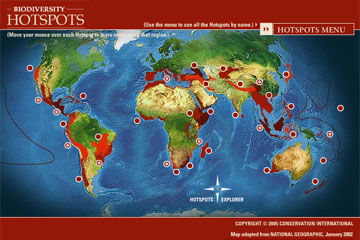 Biodiversity hotspots — there are now 34. Courtesy of Conservation International
|
In their papers, Wright and Muller-Landau acknowledge that extinction is likely to be higher in so-called biodiversity hotspots, areas with high numbers of endemic species that have already suffered large-scale habitat loss and are threatened by burgeoning population growth. Norman Myers, an Oxford University biologist who has figured prominently in conservation literature over the past 20 years, pioneered the concept of biodiversity hotspots when he identified 25 such hotspots covering 12 percent of Earth’s land surface. He found that these were home to 44 percent of vascular plants and 35 percent of terrestrial vertebrates—a discovery that provided leverage for conservation initiatives. The 16 of these hotspots characterized by tropical forest have already lost an average of 90 percent of their forest cover, according to a 2002 Conservation Biology paper by Thomas Brooks and colleagues. Species-area math predicts that this depletion alone would result in the eventual extinction of 50 percent of the endemic species in these areas.
Wright and Muller-Landau argue that, while endemic hotspot species are at particular risk, “most tropical species are found outside these hotspots . . . and inhabit one of the four great blocks of tropical forest that once covered Indo-Malaya, Mesoamerica, the Amazon Basin and Guiana Shield, and the Congo Basin and humid western Africa. Here, for the groups that have been studied (largely plants, birds, and larger mammals), most species have large geographic distributions, which should buffer them from extinction.”
Laurance disputes this claim, countering that “these areas also sustain numerous local endemics. . . . Even within seemingly monotonous expanses of forest, current and historical barriers, such as rivers, mountains and past forest refugia, have created complex patterns of species endemism. Hence, even the largest tropical forest tracts currently in existence contain many restricted endemics that are inherently vulnerable to habitat disruption.”
Wright and Muller-Landau also warn that “simple species area considerations may not predict extinctions accurately at this scale” and that “species-area curves are crude tools,” though to date, studies have found that species area curves have thus far accurately predicted extinction. However, Laurance argues that Wright and Muller-Landau’s treatment of remaining primary forest may well underestimate extinction because “they assume that surviving forests are merely shrinking in area, when in fact they are also being extensively fragmented.” Laurance, who has spent more than 20 years studying the effects of fragmentation in the Amazon, knows that a fragmented forest is a less diverse one, since primary forest conditions can be so disrupted that it leads to the eventual disappearance of forest specialists. Further, Brook and his colleagues point to extinction debt—the idea that species extinction, like global warming, has a time lag following forest clearing—as a particular area where Wright and Muller-Landau may be understating extinction risk.
“The time lags observed between habitat loss and species extinction (Brooks et al. 1999) do not imply that a window of opportunity automatically opens for species recovery—this requires expensive, logistically challenging and unattainable conservation interventions for most species at risk,” write Brook and his colleagues. “The extinction momentum implied by the species-area relationship, termed the extinction debt’ of past habitat loss (Tilman et al. 1994), is another critical hazard and inexorable threat that will drive future extinctions—even in a world with no net forest loss.”
Old growth versus secondary growth forests
While these are valid concerns, and ones that are acknowledged by Wright and Muller-Landau, the biggest questions arise from the biodiversity implications of their treatment of secondary forest versus primary forest.
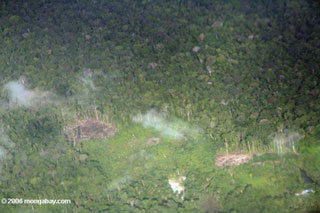
Deforestation in Colombia. This small-scale form of deforestation with adjacent primary forest areas will allow rapid recovery after the land is abandoned.
|
They note that their model treats all forest cover, whether it is centuries-old rainforest or two-year old secondary forest recovering from intensive logging and agricultural fires, as the same from a biodiversity standpoint. The problem, as any forest ecologist knows, is that secondary forest is less biodiverse than old growth forest. How much less biodiverse? That’s the big question. No one knows. There is a lack of data that can shed definitive light on the issue. This so-called “data vacuum” is also a lightning rod for criticism of Wright and Muller-Landau.
The two authors say that the transition from primary forest to secondary forest will have minimal to moderate impact on global biodiversity. Their argument is based on the key assumption that most secondary forest will be allowed enough time (generally 20 to 40 years) to develop into forest that structurally resembles primary forest amd can support species that typically require primary forest for survival. Their reasoning also assumes that sufficient areas of primary forest will persist to serve as refuges from which primary forest specialists can migrate to recovering and expanding secondary forests. Wright and Muller-Landau say that “secondary and degraded tropical forests are crucially important to conservation because of the vast areas of land involved,” noting that “there are approximately 11,000,000 km2 [square kilometers] of tropical forest today, of which 5,000,000 km2 are degraded or secondary forests.”
While Toby Gardner, a scientist from the University of East Anglia who was lead author of a recent Biotropica article, agrees that secondary forests have conservation value, he argues that because they exist in such varying degrees of degradation, one can’t presume that they will preserve most, or even some, biodiversity.
“We challenge the validity of this assumption as secondary forests are highly heterogeneous, and their potential biodiversity value can be dramatically reduced,” he says, due to factors including forest heavily degraded from fire, fragmentation, alien species, soil erosion, and disrupted seed dispersal mechanisms.
Brook and his colleagues add that while “regenerated forests are considerably better for biodiversity than agricultural or urban landscapes (Sodhi et al. 2004) and that regenerated sites can have substantial species recovery after several decades (Grau et al. 2003, Dunn 2004), it remains indisputable that secondary tropical forests represent a depauperate [stunted] community with a reduction or loss of ecosystem services.” They cite Singapore as an example:
-
“A pertinent example comes from the heavily deforested island of Singapore which contains roughly ten times more secondary than primary forest, yet the former habitat supports only 60 percent as many plant species (Turner et al. 1997). Even in areas within close proximity to primary forest, only 75 percent of forest bird species were found to be using the secondary forests of Peninsular Malaysia (Peh et al. 2005). Old-growth forests constitute a critical habitat for many tropical species that often have specific host dependencies, narrow geographical ranges, and a low tolerance to habitat fragmentation.”
Wright and Muller-Landau counter that “conservationists have only recently begun to evaluate these forests (Cannon et al. 1998, Lawton et al. 1998). Logged and unlogged forests support similar plant species diversity, and even tree species targeted by decades of selective logging maintain large populations, although not of timber-quality individuals.” They suggest that secondary forests, especially those given adequate time to recover, may well preserve more biodiversity than expected, though more studies are needed to thoroughly examine the issue.
A debate in a “data vacuum”
Wright and Muller-Landau’s outlook, given the uncertainty of research, is of great concern to other scientists, who take a fundamentally different philosophical approach on how to proceed in a “data vacuum.”
“The Wright and Muller-Landau study seems to violate the precautionary principle, which maintains that one should err on the side of caution in conservation matters,” writes Laurance. “Concerns about potentially massive species losses have provided the political impetus for substantially expanding protected areas and conservation programs in the tropics. Even if future extinctions should be lower than many anticipate (partly because of these new conservation initiatives), the population sizes, geographical ranges and genetic variation of innumerable species are collapsing under the weight of burgeoning anthropogenic threats.”
“Hence, it seems too early to put an optimistic spin on the impending loss of tropical biodiversity; far better for our great-great grandchildren to make such a propitious finding, than to celebrate now and potentially leave our descendents to discover precisely the opposite.”
   The bulk of extinction will take place among creatures we barely even know, like beetles, butterflies, and bugs. Top photos by Rhett A. Butler, bottom photo by Brodie Ferguson. |
Toby Gardner, who—along with University of East Anglia colleagues Jos Barlow, Luke Parry, and Carlos A. Peres—analyzed 37 scientific papers reporting the biodiversity levels of vertebrates (primates, amphibians, birds) in regenerating forests had somewhat stronger criticism for the work of Wright and Muller-Landau.
“In the context of the optimistic picture painted by [Wright and Muller-Landau], we argue that the current status of understanding is so weak as to invalidate any reliance upon the value of secondary forests for future conservation of tropical forest biodiversity. Whereas the model predictions of [the authors] tell us something of the future of tropical forest cover, they tell us very little about the future of tropical forest species,” wrote Gardner and colleagues. “Whereas these studies are important in unveiling potential large-scale changes in the structure and composition of tropical landscapes, our review shows that very little reliable field data are available to translate the consequences of such changes (current or future) for biodiversity.”
“In the absence of a strong empirical foundation we run the risk of making flawed and potentially misleading predictions, leading to dangerously inappropriate or complacent policy recommendations.”
Gardner further says that “these are the taxa that we understand best — therefore if our understanding is poor for them, god knows what little we know about groups of species such as insects and other arthropods.”
In response, Wright told mongabay.com that Gardner and his colleagues “condemn us for optimism presented with a data vacuum but the 37 articles they reviewed deal with uniformly young secondary forest, mostly less than eight years old for bird studies, for example. The question is not whether forest species will colonize old fields. The question is when during secondary forest succession they will be able to colonize the forest. I believe most species in Panama can do quite well in forest perhaps 20 years old and 15 to 20 meters tall. . . . Forest specialists might be doomed to extinction [but] this will depend on whether forest specialists can tolerate secondary forests. Very few forest specialists have become extinct at temperate latitudes. But the tropics might be different. So this is an unknown.”
In turn, Toby Gardner told mongabay.com he disagreed with Wright’s remarks.
“The main problem is that in many areas of the world there is pitifully little primary forest remaining for species to colonize during secondary forest succession,” Gardner said via e-mail. “It is our belief that regenerating secondary forest is unlikely to provide suitable habitat for many old-growth specialists for decades if not centuries, casting doubt on their ability to provide an effective solution to the crisis currently facing many of these species. Until we have strong evidence to support the recovery of old-growth specialists in regenerating forest, we believe that the optimistic predictions such as those by Wright and Muller-Landau can give a misleading message on the fate of tropical forest species—and most worryingly could (inadvertently) encourage complacency in the face of adversity.”
The same sentiments were echoed by Gardner and colleagues in their Biotropica paper:
-
“Tropical forests are currently facing an unprecedented level of threat from multiple factors. . . . Such threats, coupled with the poor current status of our knowledge mean that it is highly unlikely that we will fully understand the conservation value of secondary forests before we have already converted most of the remaining primary forest to other land uses. . . . We consider that the urgency of the situation strongly justifies the application of the precautionary principle. . . . We therefore agree with [Wright and Muller-Landau] that although secondary forests may be more favorable than many alternative land uses, the most pragmatic conservation recommendation currently available is to assist tropical forest countries to both maintain existing primary forest reserves and set aside new areas of old growth that remain unprotected (Fagan et al. 2006). However, we also believe that the optimistic predictions of [Wright and Muller-Landau] undermine the importance of this goal, and our concern is heightened by the fact that [their] main predictions occur in the absence of any active changes in conservation policy (thereby potentially—but unintentionally—advocating complacency). It is our conviction that we currently lack the data necessary to make robust predictions about the conservation value of secondary forests for most species. Until these data become available, predictions such as those provided by [Wright and Muller-Landau] lack any strong empirical basis, and should not provide grounds for premature optimism.”
Common ground
Harsh words aside, there are several important points of agreement between the contesting scientists. Brook, Laurance, and Gardner seem to agree with Wright and Muller-Landau’s conclusion that primary forest will continue to be depleted and converted to secondary forest at a rapid pace over the next 25 years, and that species extinction in the tropics will be significant—at minimum 10 percent at current rates. The main point of contention over extinction is not whether it will occur but the degree of magnitude—some projections are as high as 75 percent based on 90 percent loss of tropical forests, while the Wright and Muller-Landau estimates are considerably lower based on projections for less forest loss. All parties share common ground on the urgent need to further evaluate “the degree to which regenerating and degraded habitats . . . can sustain tropical biodiversity” and, most importantly of all, to conserve old-growth tropical forests for the preservation of biodiversity.
Laurance highlights some of these points of agreement in his TRENDS in Ecology and Evolution paper.
“The Wright and Muller-Landau study provides a clear rationale for projecting future species losses and highlights pressing research priorities,” writes Laurance. “Among these is the need to evaluate critically the degree to which regenerating and degraded habitats, which are increasing dramatically at the expense of old-growth forests, can sustain tropical biodiversity. Another priority is to advance our understanding of the proximate and ultimate drivers of forest loss, especially at regional and sub-regional scales, and how those drivers change in importance over time. Improving basic estimates of forest cover, loss, and regeneration for tropical nations is another key aim.”
Gardner agrees that more research is critical. He told mongabay.com:
“Our main argument is that we simply do not know enough to say, and given this predicament a precautionary approach (focused on what we know is the most effective option for conserving biodiversity, the protection of mature native forest) is the most sensible way forward and the one least likely to encourage complacency.” In principal, he agreed with one of Wright and Muller-Landau’s recommendations, that old-growth species “will require new protected areas” and that more research will need to be conducted to assess the extinction risk faced by tropical forest species.
Wright and Muller-Landau add that there are several key questions that need to be addressed to improve the effectiveness of global conservation efforts. “First,” they ask, “what proportion of tropical species is completely dependent on pristine, old-growth forests? “Second,” they continue, “how will global atmospheric and climatic changes affect old-growth and secondary tropical forests?” And further: “Where will today’s conservation efforts be most effective? Should the focus be on countries in crisis today? [Haiti]. . . . Should the focus be on countries likely to be in crisis in the future? [Congo]. . . . Or should the focus be on countries where there is even more breathing room? [Guyana].” They argue that “countries with large areas of extant forest, large projected human population growth rates, and limited protected area networks” should be the priority. Specifically, they point to the newly democratic country of Congo (DRC).
“The Democratic Republic of the Congo is a prime example,” they write. “Forest still covered 65 percent of its potential distribution in 2000, the human population is projected to increase by 312 percent by 2050, and just seven IUCN-listed reserves include forest today (another 15 reserves include savannah or shrubland). The window of opportunity to establish protected areas will soon close in the Democratic Republic of the Congo and similar countries.”
In the end, this is probably the most important conclusion of the ongoing debate: that continued research and urgent conservation action are needed to prevent species extinction. Wright and Muller-Landau are up against a number of critics who say their claim that “the widely anticipated mass extinction of tropical forest species will be avoided” goes too far. But there is no doubt that even their “rosy outlook” shows a tropical extinction rate exceeding 10 percent, and that it also exempts the potential impact of human exploitation of certain species—albeit a relatively small universe of species. And there is also the proverbial 800-pound gorilla in the closet, climate change, which some fear could be responsible for mass extinction in its own right.
- Wright, S.J. and Muller-Landau, H.C. (2006) The future of tropical forest species. Biotropica 38, 287—301
- Wright, S.J. and Muller-Landau, H.C. (2006) The uncertain future of tropical forest species. Biotropica 38, 443—445
- Brook, B.W. et al. (2006) Momentum drives the crash: mass extinction in the tropics. Biotropica 38, 302—305
- Gardner, T.A. et al. Predicting the uncertain future of tropical forest species in a data vacuum. Biotropica 39 25-30
- Laurance, W.F. (2006) Have we overstated the tropical biodiversity crisis?. TRENDS in Ecology and Evolution 22 65-70
>Hugg this article | Contact
